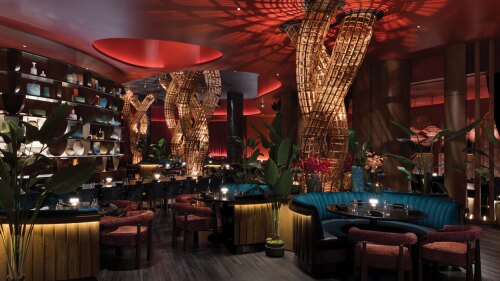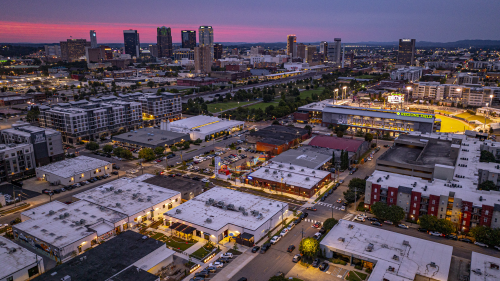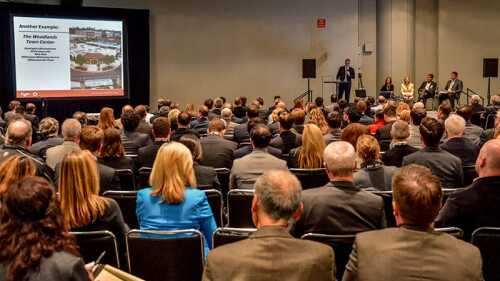Property Types
Hotels and Resorts
The hotel industry in the United States faces complex challenges in 2025, according to Jan Freitag, national director of hospitality analytics for the CoStar Group. During the “State of the U.S. Hotel Industry” presentation at the ULI 2025 Spring Meeting in Denver, Colorado, Freitag highlighted the challenges facing the hotel business amid macroeconomic uncertainty.
Once a sprawling expanse of uncharted land, Las Vegas, Nevada, has evolved into the entertainment capital of the world, a gaming super-hub, and a premier destination for sports. This remarkable transformation didn’t happen overnight; it stemmed from decades of strategic planning, investment, and visionary zoning recommendations.
Las Vegas is unlike any other place in America. Each year it draws more than 40 million visitors to the dazzling casinos and hotels that “turn night into daytime”—and transform the city into a glittering jewel in the desert. With 164,000 hotel rooms, Las Vegas is the largest hospitality market in the U.S.—outpacing Orlando, Florida, the next biggest market, by approximately 15 percent, according to JLL.
Industrial
Standing in the shadow of Regions Field and within earshot of Railroad Park, Birmingham’s Urban Supply hints at what the next chapter of downtown life could look like. Once-quiet brick warehouses are being steadily reimagined into patios, storefronts, and gathering spaces along a new pedestrian alley. Early tenants have begun to open their doors, and programming is slowly bringing people into the district. While the project is still in its early stages, the framework is in place for a vibrant hub that will grow block by block in the years ahead.
What trends are shaping the future of the industrial sector? Four experts from ULI’s Industrial and Office Park Development Council talk about the industrial submarkets and property types that offer the greatest opportunities, challenges developers face in bringing new projects to market, ways artificial intelligence and emerging technologies are reshaping the sector, tenant priorities, and other key trends.
After a quiet first half of 2024, CMBS originations increased 59 percent in Q3 on a year-over-year basis, according to the Mortgage Bankers Association’s Quarterly Survey.
Mixed-Use
The National Bus Rapid Transit Institute identified seven elements as those undergoing innovation in bus rapid transit.
Successful transit-oriented developments (TODs) meet demand for compact, walkable, mixed-use development-the same markets that are also likely to see an important amenity value in easy access to high-quality transit service. At the same time, the more people, jobs, and services that exist within walking distance of transit service, the higher the potential transit ridership and fare generation, and the more cars that can be pulled off congested roads. TOD is a win-win for land use and transportation.
A focus on affordable living considers both housing costs and commuting costs, an element the federal government now says it is serious about using as a benchmark.
Multifamily
As congregations across North America grapple with shrinking membership and aging facilities, a new opportunity is emerging: transforming faith-owned land into affordable housing and community-serving spaces. At the 2025 ULI Fall Meeting in San Francisco, panelists in the session “Spiritual Brownfields: Declining Congregations and Opportunities for Housing on Faith-Owned Land” explored how churches and developers are partnering to bring mission-driven housing to underused sacred sites.
At the 2025 ULI Fall Meeting in San Francisco, leaders from across the development and construction industries discussed how they are adapting to a volatile yet stabilizing housing landscape in a session called “Report from the Field: Wrestling with the Cost of Housing Construction.” Despite headlines about tariffs, labor shortages, and inflation, the panelists agreed that the cost environment has settled into what one called a “new normal.”
A panel of insiders reveals what’s true—and false—about the housing crisis and how to fix it.
Office
Five members of ULI’s Office Development Council speak about the trends affecting their market, including opportunities for development and investment, the evolution of tenant needs, and the challenges of adaptive use. Learn whether they think there is value in certification under the Leadership in Energy and Environmental Design rating system.
After a half decade of smallish pilot commercial programs, the retrofit financing structure known by the acronym PACE—for property-assessed clean energy—is becoming available to owners in several major markets, including Washington, D.C., Los Angeles, and San Francisco. Read how it works, and the differing approaches being taken in different cities in implementing the program.
The U.S. office market has shifted its geographic momentum this year, with central business districts (CBDs) and popular urban corridors recovering better than suburban markets. One significant sign of the improving health of CBDs has been a notable increase in corporations migrating from outlying suburbs to downtown or urban locations. Read what three ULI members have to say about his trend.
Residental
Through both evidence and anecdotes, panelists at the “How Housing Matters”conference provided further insight into the pivotal role that housing plays in people’s lives.
Master-planned communities and suburban models that once dominated homebuilding are shifting to include walkable, compact town centers.
Panelists advocated for policies leading to healthier lives, built on a platform of affordable, green, and community-oriented housing at the 2014 ULI Fall Meeting in New York City.
Retail
For decades, civic leaders have tried to revitalize Market Street, San Francisco’s central thoroughfare, only to see their efforts founder. “I sometimes call it the great white whale of San Francisco,” says Eric Tao, managing partner at L37 Development in San Francisco and co-chair of ULI San Francisco. “Every new mayor, every new planning director, every new economic development director has chased that white whale.” This year, however, an international competition of ideas hosted and run by ULI San Francisco, with support from the ULI Foundation, generated fresh momentum for reimagining the boulevard. The competition drew 173 submissions from nine countries and sparked new conversations about the future of downtown San Francisco.
The OAK project began in 2009, when a development firm set their sights on the corner of Northwest Expressway and North Pennsylvania Avenue, the state’s most important and busiest retail intersection. As the region’s only parcel capable of supporting a vertically integrated project of this scale and density, that land represented an opportunity to create something truly special.
As aging retail continue to evolve, one increasingly popular trend has been to redesign malls as town centers—recalling a time when such commercial districts were the heart and soul of a community. Mall–to–town center retrofits are emerging throughout the nation, especially in suburban communities, where pedestrian-friendly, mixed-use environments are highly attractive to millennials now raising families.

















